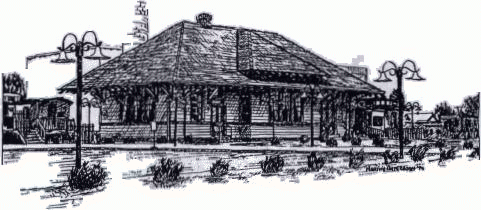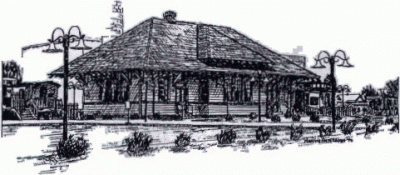A brief history of: the Lake Ontario Shore Railroad; the Rome, Watertown & Ogdensburg Railroad; division of the New York Central and the Hudson River Railroad; the Ontario Midland; the R.G.&E. line. Also known as “the Rotten – Wood & Old Rusty Rails.”
by Dick Batzing – Webster Historian
By the 1850’s, shortly after Webster separated from the Town of Penfield, there were many people in the town who began to realize Webster had been by-passed by the Erie Canal which opened in 1825 and also by the New York Central and Hudson River Railroad in the 1830’s.
The farmers and merchants of Webster had three options for shipping their produce or products to area markets, primarily in Rochester. The first choice was an all day drive with a team and wagon to and from the city via the “Float Bridge” on the southern end of Irondequoit Bay. The second choice was an eight mile trip to Fairport and there meet a barge on the canal or a local (train) on the New York Central. A third choice was to ship by one of the schooners which frequented Nine Mile Point on Lake Ontario.
Many of the same men who promoted the formation of the town in 1840 were also the strongest advocates of a railroad through Webster: Timothy and William Corning, bankers; Dr. Oliver Reynolds and Dr. John Dunning; H. Nelson Curtice, a prominent businessman and an elected town supervisor who served for four different terms; Lewis J. Billings of Old Ridge Nurseries and Charles Wright Sr., a wheat farmer and threshing machine owner and operator who was also a three time elected supervisor serving for 5 terms.
For many years these men supported the idea of a rail line which would run more or less traverse the northern towns of the five counties lying just south of Lake Ontario. They worked with representatives from all the towns between Lewiston on the Niagara Frontier to Oswego on the east. The Lake Ontario Shore Railroad Company organized in Oswego on March 17, 1868. Work on the railway began in August of 1871 in Red Creek, Wayne County. Fifty-five miles were placed under contract by winter. In June of 1872 the contractors began to survey the right of way through Webster. According to Esther Dunn, “some citizens pulled up the surveyors’ stakes as soon as they were driven. One engineer was brought before a local Justice on charges of assault. It was claimed the engineers were lawless in running across grain fields, tearing down fences and cutting down trees.”
“Some citizens pulled up the surveyors’ stakes as soon as they were driven. One engineer was brought before a local Justice on charges of assault. It was claimed the engineers were lawless in running across grain fields, tearing down fences and cutting down trees.”
Esther Dunn
The railroad was completed as far west as Kendall in 1875. In that year the partially completed Lake Shore railroad was sold to the Rome, Watertown and Ogdensburg Railroad. In the following year, 1876, trains of the old Lake Ontario shore/new R.W. and O.R.R. actually arrived at and departed Webster station.
Lewis J. Billings soon became the man of the hour! In that same year he became a member of the first Board of Education in Webster when the Union School was opened on South Avenue in the village. The people were also impressed enough by his accomplishments with the new school and the new railroad that Lewis Billings was twice elected as supervisor of the town.
There are many legendary stories regarding the Rome, Watertown and Ogdensburg Railroad – the R.W. & O.R.R. (translated in time to mean “Rotten Wood and Old Rusty Rails.)
Samuel Pierce, a pioneer settler and developer who owned considerable property in Webster at the junction of Irondequoit Bay and Lake Ontario, gave land for the railroad right of way with the provision that a railroad station be built on his property and be named “Pierce’s Station.” A station was built near Pierce’s blacksmith shop, apple drying house and general store.
The little station house, through the efforts of Horace Pierce, Samuel’s son, was eventually moved east to the Forest Lawn area and there a post office was established at the station house.
Tragedy struck Webster just before 6 o’clock in the morning of August 10, 1889 at Pierce Station. As residents of the Forest Lawn area were boarding the morning “stub” train heading west to Charlotte and then south to Rochester, the late “flyer” west bound from the Thousand Islands, crashed into it. Somewhere the railroad signals were not working. The commuter train cars were virtually demolished; the steam locomotive of the speeding flyer was thrown from the tracks and exploded. Many passengers and train personnel were either killed or injured. The wreck brought doctors in from all the neighboring towns as well as physicians and nurses from Rochester. Many Webster homes became temporary hospitals where the injured were cared for.
Prior to this time, automotive [sic] brakes were not in general use on the railroads. This Webster accident served one good purpose – it brought about the installation of this new safety device on the R.W. & 0. passenger trains and on other railroads as well.
During the years of the R.W. & 0.R.R., many other railroad accidents occurred: at the crossing in the village of Webster on North Avenue, L.R. Boyston, his daughter, Mrs. Frank Palmer and her child lost their lives. As a result of this village accident, a watchman was hired to be on duty at that crossing from sun-up until sunset. The most notable watchman/crossing guard in Webster was George Wood. Mr. Wood served until electric signals came in the 1930’s. At the Webster Museum, there are photographs of the Forest Lawn accident, George Wood at the crossing and also photos of a derailment of freight cars on a siding at the Webster Basket Factory. Roger Wall, son of George Wall who was Webster’s first historical photographer, took photographs of the Basket Factory derailment in the late 193O’s.
Other fatal accidents occurred at other crossings. Fred Sutter lost his life on Salt Road and two separate accidents on Phillips Road crossing took three other lives.
The biggest and most important activities of the railroad took place what was to become the Village of Webster. Just north of the Ridge Road and the “Four Corners” and along the tracks, many early Webster industries and businesses had their beginnings in the 1880’s and ’90’s.
The “Webster” station was a center of much activity. The surrounding area had become one of the finest and largest producing orchard regions in the country. Frequently, in the fall, the rail company was hard pressed to supply sufficient freight cars for apple shipments alone. “John W. Hallauer and Sons Evaporated Fruits” was only one of over 30 “dry houses” in Webster which shipped produce on the rails; thus Webster was called the “Dried Apple Capitol the World.” Gottlieb Kittelberger and his two brothers began the Basket Factory along the tracks which in the early 1900’s became the largest and most productive basket factory in the world. The Webster Canning and Preserving Co. began as the Curtice Preserving Co. on a spur of the railroad in 1885. Jiust a few years ago the old preserving company buildings burned to the ground. Nelson Curtice’s name continues on even today. The next time you buy a Blue Boy, Silver Floss or Comstock canned product, you’ see at the bottom of the can or package in fine print, “Curtice-Burns”. If it hadn’t been for the railroad there might not have been a Curtice-Burns, a Martin Bros. Lumber Co. or a Webster Lumber Co. with its own Spur in late years on Holt Road. Certainly the LeFrois Pickling Factory, or the apple vinegar factory, would not have existed without the railroad.
Perhaps if there had not been a Webster railroad, Birdie Hart, who lived just east of the Basket Factory in 1904, would not have been murdered by Erwin Smith in the Hallauer Dry House. But that’s another story to be told at another time.
The Webster Station also had four passenger trains a day, two each way one in the early morning and another in the late afternoon. This made it possible for workers as well as shoppers to ride the rails to Rochester every day. In the early days, travelers would catch the New York Central branch at Charlotte and later they could ride the trolley from the Sea Breeze Station into the city.
At the turn of the century, progress began to decline for the steam engines and trains in Webster. In 1900, the Rochester to Sodus Bay Railway Co. – an electric trolley called the Royal Blue Line, began its run from Rochester to Sodus Point a dozen or more times a day. Passengers preferred the more frequent and often shorter route of the trolley. The Post Office soon realized the benefits as did many small fruit and vegetable growers.
In 1914, the Rome, Watertown and Ogdensburg Railroad became a part of the New York Central system. Private automobiles and large motor trucks have not only caused the doom of the railroad but of the trolley line as well. In 1929 the last trolley made its run from Sodus to Rochester and in 1964 the depot at Webster closed its doors.
During the past 30 years, the bridge at the Irondequoit Bay outlet was severed. Xerox has been the only major user of what’s now called the Hojack Line, bringing in and shipping out from Sodus and the east.
The 1990’s saw Rochester Gas and Electric as the owners of the major portion of the 100 feet wide right of way and in 1997, the story of our proud train becomes a walking trail of tall tales of an almost forgotten train.
THE HOJACK STATION

Many people fondly called the R.W.& 0. by its nickname, “Hojack.” It seems that in the early days of the railroad, a farmer in his buckboard drawn by a bulky mule was caught on a crossing at train time. When the mule was halfway across the tracks, he simply stopped. The train was fast approaching and the farmer naturally got excited and began shouting, “Ho-Jack, Ho-Jack.” Amused by the incident, the trainmen began calling their line the “Ho-Jack.”
The original station office was connected to the existing freight house but fire destroyed that part about 75 years ago. A retired passenger coach served as an office while a new station was being built. This station continued with diminishing use until it was closed in 1964.
1972 saw the station moved from its original site west of North Ave. to its present location as past of the Hojack Restaurant, which opened in 1974. Later the restaurant under different management became the Loose Caboose, the Webster Town Lounge, a Jamacian Restaurant and closed as the Pufferbelly. Today it is a child care center, Toddlers’ Workshop Child Care Center.
